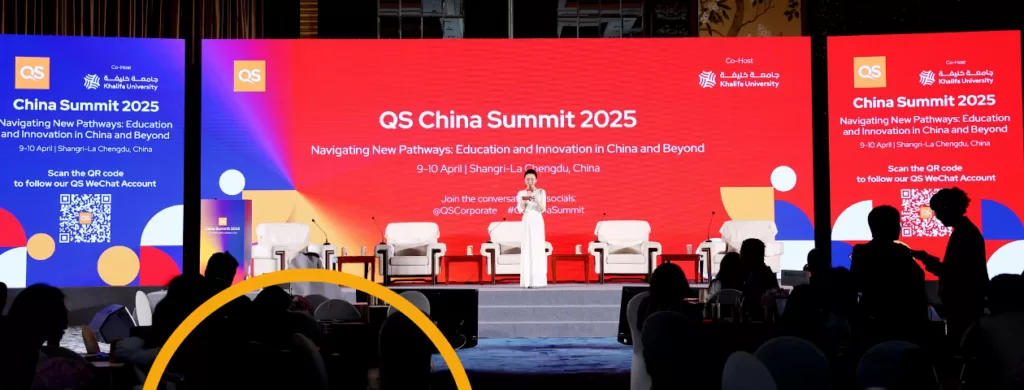
China has made strides in recent years to move away from its reputation of a country that thrives on its exports. There is one resource, however, for which it remains comfortably the world’s biggest supplier: international students. The sheer volume of internationally-mobile Chinese students has led to concerns in popular destination counties such as the US or the UK that universities have become over-dependent on the income generated by these high-fee paying incoming students, particularly at postgraduate level.
These fears have been exacerbated by recent trends in the US; namely, three consecutive years of declining applications at postgraduate level from China, according to figures from the Council of Graduate Schools. Cause for concern? Well, yes – for many institutions around the world, very much so. The story, however, is not quite so simple. What we are seeing, says Dr Rahul Choudaha, chief knowledge officer & senior director of strategic development at World Education Services until December 2015 and principal researcher at DrEducation, is rather shifting demographic trends.
“There are a smaller number of students applying at master’s level, but there is much bigger demand at undergraduate and even high school level.” This is, of course, a consequence of a hugely expanded middle class he explains. Choudaha breaks down internationally-mobile students into four categories, based on two axes – financial resources and academic preparedness. While traditionally, those with a high level of academic preparedness but with lower financial resources – ‘strivers’ – have dominated, growing affluence has led to a rapid increase in ‘explorers’, those with high financial resources, but lower academic preparedness.
While strivers tend to target funded postgraduate programs, explorers are more likely to apply to undergraduate programs – hence we have seen a huge surge in Chinese applications at this level in countries like the US, the UK and Australia.
US education as a luxury product
This is particularly advantageous to American institutions, explains Choudaha, due to the global cachet of the US brand. “For those with money, it is like a luxury good, for which they are willing to pay extra due to the esteem in which it is held. This feeds into a higher propensity to absorb the costs (let us not forget the often astronomical cost of US higher education). Even if you create a world-class university, and put it in a country without high reputational value, you will struggle to convey its quality. The analogy is wine from France. You try to grow it in India and, even if it is the same quality, it won’t be treated that way. Country reputation is a very important filter of quality, as well as university reputation. There is a multiplying effect when we have both, not even an additive effect.” Good universities in the US, therefore, stand to be the biggest beneficiaries of a growing Chinese middle class.
“This image comes from multiple layers: The sociocultural, the aspirational, people already living there – the diaspora. Plus, there’s exposure through popular media, something as simple as Google being the de facto choice of search engine. Engineering or technology and business are the two biggest academic fields. Both are so dominated by American enterprises, that American universities are naturally seen as a good pathway to employment and engagement.”
Does this conception of education as a luxury product affect subject choice? Somewhat, says Choudaha. Explorers, he reflects, are more likely to study business than engineering or technology, though the latter is a close second. At postgraduate level, where we are more likely to find strivers, there is a greater preponderance of engineering and tech students. “The ROI equation is much stronger at postgraduate level, with people considering employability a lot more. The demand -supply equation is very different for engineering; there’s a much greater opportunity for jobs. Even visa policies are different. An F-1 Optional Practical Training (OPT) visa allows for a 29-month stay after graduation in STEM subjects, though there has been controversy around this, while a business degree allows only for 12.”
If US higher education is insulated from attrition due to its cachet for those who can pay and can afford to pay less heed to ROI, does it follow that strivers would be more inclined to consider a greater number of study destinations? “We have seen indicators that those who are searching for value will compromise on geography within countries, or even consider different countries. Explorers, on the other hand, can be more specific.” The nature of the agency system in China means, he suggests only half-jokingly, means you if you can pay enough money you can “land wherever you want”.
Sea turtles on the rise
The return on a degree abroad has come into question in recent years. The volume of Chinese students studying abroad is not only a prospective time bomb for universities who become over-reliant on the inflow of international students, but also to the students who hoped to find themselves at an advantage in the employment market. Jobs often prove hard to find in study destinations, with visa issues compounding the challenges faced by graduates in the post-recession landscape. Thus we have a huge volume of returnees, labelled ‘sea turtles’ in Chinese slang, who are entering a market that is increasingly competitive; to the degree that a US education may not even be an advantage. The result, naturally, is dissatisfaction with the experience.
“The number of sea turtles is getting larger,” says Choudaha. “That’s the group that is dissatisfied, giving a view that the ROI on American education is not all it’s made out to be. That’s where more needs to be done about setting expectations on the recruitment and admissions side; whatever outreach mechanism schools are using.”
Indeed, universities need to do more, he believes, both in terms of painting an accurate picture of what students can do on graduation, and in terms of offering academic and career support. “There is a perception and reality gap. Whatever decisions the student makes are based on what they perceive to be the opportunities when they land – but it’s not easy for a non-English speaker to find and retain a job in the US. There is also notable gap between what institutions communicate on the admissions side and what they provide in career services. A lot is done to get students on campus, but there is nowhere near as much research and practice done into how to make that student succeed.”
Institutions must do more to bridge perception and reality gap
The key finding of research conducted by Choudaha with NAFSA (Bridging the Gap: Recruitment and Retention to Improve International Student Experiences, co-authored by Paul Schulmann) is that, at undergraduate level, a lack of employability prospects and career outcomes were leaving international students dissatisfied with their experience. Some interesting contrasts in the viewpoints of students and institutions are thrown up by this research. While institutions believe that students leave for reputational, financial and academic reasons (as well as difficulties with the English language), students cited access to jobs, affordability and scholarships as the things with which they were least satisfied. While the latter suggests that perhaps institutions are not doing enough to fully communicate the costs of study, and the availability – or lack thereof – of funding, might the former also suggest that institutions are not being stringent enough in who they are admitting?
Indeed, Choudaha believes that we will not see a decrease in demand for US higher education from Chinese students – though naturally, we must factor in the potential effects of any ‘black swans’ (recent wobbles in Chinese economic growth may well have been noted with concern by international student recruiters) – we will see a change on the supply side. “There are US institutions with unsustainably high levels of Chinese students. This will eventually have an impact on institutional reputation, pressurizing institutions to be more selective.” With the Chinese higher education landscape unable to accommodate growing demand for higher education, leading to extreme selectivity, explorers will continue to look outward as long as they can afford to pay – or think they can.
While growing affluence in China has certainly served to benefit many institutions looking to internationalise, as well as bolster their coffers, the changing paradigm will require careful management from universities looking to recruit sustainably and ethically.



